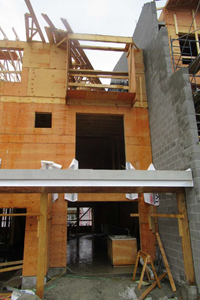Worker seriously injured in fall from job-built scaffold
Date of incident: May 2021
Notice of incident number: 2021188280014
Employers: Residential framing company (2; one subcontracted by the other); construction management company
Incident summary
At a residential construction site, a worker was installing wood roof trusses on the third floor of a new townhouse. The worker was standing on a job-built wood scaffold and was handling a bundle of trusses that were individually nailed to a 2×4 wood plank. The 2×4 was in turn nailed to the wood frame of the third floor to hold the bundle in place. The worker removed a nail from the 2×4 to release the truss it was holding from the bundle. The truss bundle scattered, which caused the worker to slip off the scaffold and fall through a window opening to the unsheeted joists of a second-floor deck. The worker’s fall was measured to be 4.6 m (15 ft.). The worker sustained serious injuries.
Investigation conclusions
Cause
- Worker fell from inadequate job-built scaffold. The worker was unable to hold the destabilized trusses in place as they scattered. The force of the scattering trusses knocked the worker off the scaffold platform. The job-built wood scaffold measured 23.5 cm (9¼ in.) in width. According to the Occupational Health and Safety Regulation, the width of such a scaffold must be 50 cm (20 in.). The scaffold also did not comply with WorkSafeBC standards for wood scaffolds. The top rail was approximately 0.9 m (2 ft. 11½ in.) above the surface of the wood platform and not the required 1 to 1.1 m (40 to 44 in.). The scaffold lacked a mid-rail, and it had no toeboards to mitigate the risk of slipping.
Contributing factors
- Lack of hazard identification. Workers of the subcontractor framing firm (subcontractor) had not carried out a hazard identification and risk assessment for the task they were performing. The subcontractor had documented safe work procedures (SWPs) for constructing job-built scaffolds and for working at height, which referenced the use of fall protection measures. No such measures were put in place. Had the high-risk hazard of falling from the third-floor scaffold to the second-floor deck been identified, the risk of the fall hazard could have been assessed, and controls such as fall protection measures could have been implemented to mitigate the risk.
- Lack of fall protection. The distance from the platform of the scaffold to the second-floor deck was approximately 4.6 m (15 ft.). The subcontractor’s health and safety program documentation clearly identifies the requirement that a fall restraint or fall arrest system be used when there is a risk of a fall from an elevation of 3 m (10 ft.) or greater. The worker was not wearing fall protection equipment when he fell from the wood scaffold.
- Inadequate adherence to health and safety program.
- The subcontractor failed to ensure that its occupational health and safety program was followed. The firm failed to ensure that established SWPs were fully implemented and that risks were mitigated. Specifically, the firm failed to ensure the scaffold was built with regard to safe work procedures for erecting scaffolds and that it complied with WorkSafeBC standards.
- The contractor framing company (contractor) failed to ensure that representatives of all of its subcontractors attended the construction management company’s mandatory, regularly held site safety meetings, as evidenced by the fact that no representative from the subcontractor attended the safety meeting held on the day of the incident.
- Likewise, the construction management company failed to ensure that representatives of all contractors and subcontractors attended its safety meetings, again as evidenced by the fact that no representative of the subcontractor attended the safety meeting held on the day of the incident.
- Ineffective supervision. The subcontractor failed to identify hazards created by unsafe conditions at the workplace that included unguarded window and floor openings. It also failed to ensure that workers followed established SWPs when constructing scaffolding and that fall protection systems were used.
- Inadequate training. The subcontractor failed to adequately train its workers. Its training regimen consisted wholly of on-the-job training, which proved to be inadequate, as evidenced by the use of the inadequate constructed scaffold platform and the lack of fall protection compliance with the firm’s occupational health and safety documentation.
- Inadequate health and safety coordination.
- The construction management company held regular mandatory site safety meetings for all contractors and subcontractors working at the townhouse development. As mentioned, the subcontractor did not have a representative attend the safety meeting that was held on the day of the incident.
- Both the construction management company and the contractor had a responsibility to ensure the safety of any worker performing work for them in their workplace. Had those two employers had a system that effectively coordinated health and safety communication, they would have ensured that a representative of the subcontractor attended the safety meeting held on the day of the incident. Fall protection was specifically discussed at that meeting.
- Weather conditions. Workers were exposed to wind, cold temperatures, and heavy rain. The rain saturated all wooden surfaces of the open third floor of the townhouse, making those surfaces slippery.
Other safety issue
- Unguarded stairwells. Workers were exposed to unguarded stairwells that posed a fall hazard that was greater than 122 cm (4 ft.). Although this did not contribute to the incident, it was a violation of the Regulation.

